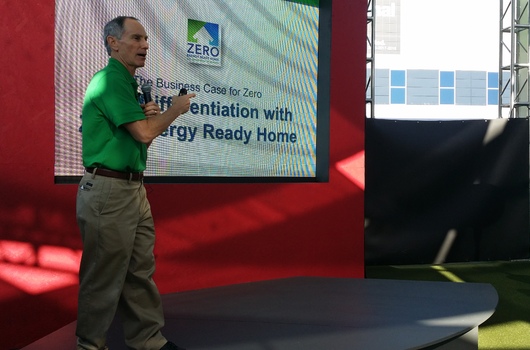How can builders sell net-zero-ready homes?

Sam Rashkin on selling net-zero-ready homes to consumers, and the problem with technical jargon.
Sam Rashkin hates technical terms. “Consumers understand what a fresh air system is,” he said to an audience at the BASF house during the International Builders’ Show (IBS), “so that’s the term I use.”
Rashkin is the Chief Architect for the Department of Energy’s Building Technologies, and he was talking not only about what goes into a zero-energy ready home, but how builders can sell those homes to consumers.
“People are making the largest investment of a lifetime and they might care whether they have a choice—whether their purchase will be illegal to build in three or four years, or if it will stand the test of time for decades to come.”
You have the 2020 model house right there on the books—that’s what you should be selling to."
Not building to the next code on the books? That doesn’t make any sense, Rashkin said bluntly. “It’s like knowing the 2016 model car is in the showroom next door and you are not going to sell that car. You have the 2020 model house right there on the books—that’s what you should be selling to.”
The big three sells
If a builder is looking to sell zero-ready homes, there are three main differentiators they can highlight.
First up? Health.“People are spending three, four and five times more for healthy choices,” said Rashkin, pointing to the growth in the organic food industry. “People want healthy choices and you have that optimized enclosure, the comprehensive system —your house is health-ready.” Rashkin acknowledged that while builders can’t legally guarantee that the house is healthy because homeowners can bring in furniture or other materials with contaminants, it is health-ready and you’ve “teed it up and that’s a big market advantage.”
People are spending three, four and five times more for healthy choices…”
The house is also tech-ready, and that, too, is something to sell on. “It’s an advanced technology home. You have ultra-low HVAC, and then if you put in all these energy efficient components throughout the house, the lighting, the appliances, the fans, the controls—now all of a sudden you have a house that has better quality products that perform better and have advanced control technology. In today’s market, as we try to grab the younger generation of buyers, they are completely in-tune to having advanced technology solutions.”
The last differentiation? It’s solar-ready. “That house can be augmented and ready to go to zero by doing simple things, like pre-wiring the house so you can run the wire from the roof to the panel and not have to destruct the construction,” Rashkin said. And you can do simple things to help the homeowner. Like giving them the structural calculations for the roof, Rashkin said. “They won’t have to spend $1000 or $2000 for an engineer to do the structura calculations and verify that the roof can handle the load for the solar panels. Very simple details and now you can promote your house as net-zero-ready.”
Everyone is saying their house is 'better'".
Better than "better"
There's a problem, however. “The challenge right now is translating it for the consumer. I can’t sell more comfort, more health, more durability because everyone out there is saying it—it doesn’t mean anything,” Rashkin said. "I need something better than ‘more.’ I need something better than ‘better’—everyone is saying their house is ‘better.’ What message do I have that would make a consumer want to buy this house?"
The Experts’ Choice
“Have you ever been in a buying situation, like I have, where I didn’t know a thing about large screen TVs,” Rashkin asked. “When the sales person told me this is the set he purchased, I was all over that. Knowing this person spends 40 hours a week selling TV sets and this is the set he wants, that’s a big deal for me.”
That’s the consumer message, Rashkin suggested. “A net-zero-ready home is the choice of experts. Flat and simple.”
Buying a home is difficult, Rashkin reiterated. If builders can point to why the experts prefer zero-energy homes, in language that is devoid of any technical jargon, they’ll make the decision process easier for the consumer.
Positioning net-zero-ready homes as the experts’ choice also helps address the perceived higher costs. “Leading experts know that the cost of your home is not just your monthly mortgage,” Rashkin explained. “The second largest expense you have as a homeowner is your utility bill. So, sure, a zero-energy ready home may have a higher monthly mortgage, but with such a lower utility bill, you have a lower cost of ownership but own a more valuable asset—something that from the very beginning is worth more and has so much potential to increase in value.”
“Net-zero-ready homes is the choice of experts. Flat and simple.”
It’s a tricky space for builders to be in, Rashkin acknowledged. “Many times your attorney’s won’t let you say all those things.” But, he said, you can use the Department of Energy’s resources, which has wealth of material that builders can use when selling net-zero-ready homes. There are comparisons of net-zero-ready homes with Energy Star homes and minimum code homes, case studies, videos, and estimated cost breakdowns.
“I can give you that language,” Rashkin summed up. “Leverage us.”
You can find more information at the Department of Energy here, or visit Sam Rashkin here.













